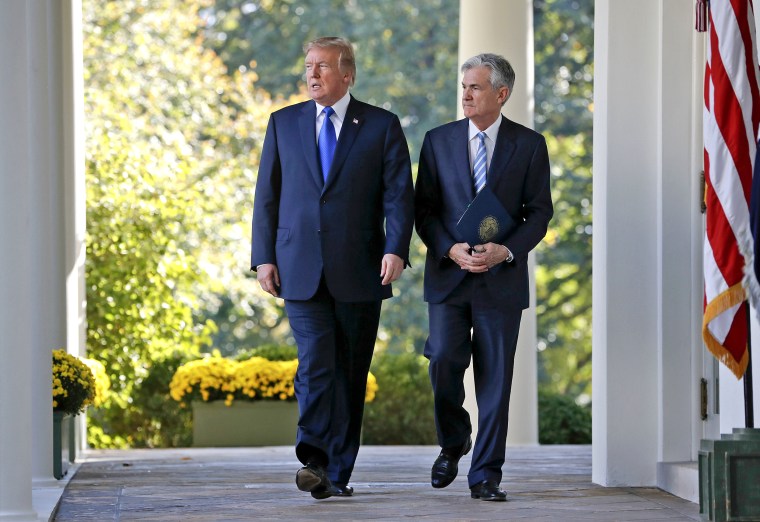Trump's Fierce Criticism Of Jerome Powell: A Demand For Removal

Table of Contents
The Roots of Trump's Discontent
Trump's presidency unfolded against a backdrop of steady economic growth, but his vision for even faster expansion clashed sharply with Powell's approach to monetary policy. Trump, inheriting an economy already recovering from the 2008 financial crisis, aimed for sustained high growth fueled by tax cuts and deregulation. He expected the Federal Reserve to maintain low interest rates to stimulate borrowing and investment.
However, Powell, tasked with maintaining price stability and full employment, took a more cautious approach. His actions frequently contradicted Trump's desires, leading to escalating tension.
- Powell's gradual interest rate hikes: Despite Trump's public pleas for lower rates, Powell gradually raised interest rates in response to rising inflation, a move Trump saw as undermining his economic agenda.
- Disagreements over inflation targets: Trump frequently criticized Powell's inflation targets, believing they were too restrictive and hindering economic growth. He advocated for a more expansionary monetary policy, even if it risked higher inflation.
- Trump's belief that Powell's policies hampered economic growth: Trump consistently blamed Powell's policies for any slowdown in economic growth, arguing that the Fed was stifling the "Trump economy."
Public Attacks and Their Implications
Trump's discontent wasn't confined to private meetings. He unleashed a barrage of public criticism against Powell, employing his favored communication channels – Twitter, speeches, and interviews – to express his displeasure. These attacks were unprecedented in their intensity and directness.
- Examples of public attacks: Trump frequently labeled Powell's policies as "crazy" and "incompetent," openly questioning his competence and motives. These public pronouncements went far beyond typical presidential expressions of disagreement with Fed policy.
- Market reaction: These attacks caused significant volatility in the financial markets, raising concerns about the Fed's independence and its ability to make impartial decisions. Investors reacted negatively to the uncertainty created by the public feud.
- Implications for the Fed's independence: The President's open criticism raised serious questions about the Fed's ability to function independently from political pressure. A politically influenced central bank risks compromising its credibility and effectiveness.
The Constitutional and Practical Challenges of Removing Powell
Removing the Chair of the Federal Reserve is not a simple matter. While the President appoints the Fed Chair, removing them requires navigating significant constitutional and practical hurdles.
- Fed's independence from the executive branch: The Federal Reserve is designed to be independent from the executive branch to prevent political interference in monetary policy decisions. This independence is crucial for maintaining the credibility and effectiveness of the central bank.
- Limited grounds for removal: The Fed Chair can only be removed for "cause," a high legal bar that would be difficult to meet simply based on policy disagreements. This safeguard protects the Fed from partisan influence.
- Potential ramifications of a politically motivated removal: Attempting to remove Powell solely because of policy disagreements would have severely damaged the Fed's credibility, potentially destabilizing the US economy and undermining confidence in the dollar.
Alternative Explanations for Trump's Actions
While economic policy disagreements were central to the conflict, other factors likely influenced Trump's actions. His attacks on Powell might have been partly motivated by:
- Political strategy: Criticizing the Fed could have been a way to deflect blame for economic slowdowns or to rally his base.
- Public image: Presenting himself as a strong leader willing to challenge established institutions might have been part of Trump's broader political strategy.
Conclusion: Understanding Trump's Demand for Powell's Removal
Trump's fierce criticism of Jerome Powell stemmed from fundamental disagreements over monetary policy, specifically interest rates and inflation targets. His unprecedented public attacks on the Fed Chair raised concerns about the central bank's independence and the potential for political interference. However, the constitutional and practical barriers to removing Powell prevented Trump from realizing his goal. This episode underscores the delicate balance between presidential power and the autonomy of independent institutions, and the significant ramifications of public clashes between the executive branch and the Federal Reserve for the stability of the US economy. We encourage you to further research "Trump's fierce criticism of Jerome Powell" and its lasting impact on US economic policy, and share your thoughts in the comments below.

Featured Posts
-
 Alterya Acquired By Chainalysis A Strategic Move In Blockchain Technology
Apr 23, 2025
Alterya Acquired By Chainalysis A Strategic Move In Blockchain Technology
Apr 23, 2025 -
 Guemueshane Kar Tatilinin Son Durumu Okullar Kapali Mi
Apr 23, 2025
Guemueshane Kar Tatilinin Son Durumu Okullar Kapali Mi
Apr 23, 2025 -
 Cincinnati Reds Continue Historic Losing Streak With Another 1 0 Loss
Apr 23, 2025
Cincinnati Reds Continue Historic Losing Streak With Another 1 0 Loss
Apr 23, 2025 -
 Emballages Reutilisables Hipli Une Alternative Durable Aux Colis Jetables
Apr 23, 2025
Emballages Reutilisables Hipli Une Alternative Durable Aux Colis Jetables
Apr 23, 2025 -
 Brewers Path To The Postseason Overcoming Early Season Challenges
Apr 23, 2025
Brewers Path To The Postseason Overcoming Early Season Challenges
Apr 23, 2025
